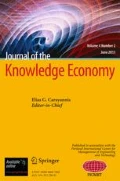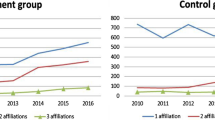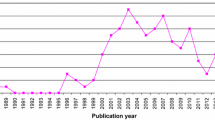Abstract
Using the case of European Union Cooperation in Science and Technology Actions, this paper investigates why despite the small scale of funding provided and substantial scientific and management workload, researchers are increasingly interested in formal networking research funded by the European Union. This paper empirically examines this motivation while controlling for researcher scientific domain, country of work and previous experience of such funding. We find that most researchers are primarily driven by a need to meet peers and that over time researchers view such funding scheme significantly less as additional funding and more as a venue for meeting peers and for disseminating research results.




Similar content being viewed by others
Notes
Composition of macro-geographical (continental) regions, geographical sub-regions and selected economic and other groupings suggested by the UN Statistics Division: http://unstats.un.org/unsd/methods/m49/m49regin.htm#europe
References
Abramo, G., D’Angelo, C. A., & Murgia, G. (2013). Gender differences in research collaboration. Journal of Informetrics, 7(4), 811–822. doi:10.1016/j.joi.2013.07.002.
Abu-Zidan, F. M., & Rizk, D. E. E. (2005). Research in developing countries: problems and solutions. International Urogynecology Journal, 16(3), 174–175.
Ahuja, G. (2000). Collaboration networks, structural holes, and innovation: a longitudinal study. Administrative Science Quarterly, 45, 425–455.
Aldrich, H. (1979). Organizations and environments. Englewood Cliffs: Prentice-Hall.
Allen, M. P. (1974). The structure of interorganizational elite co-optation: interlocking corporate directorates. American Sociological Review, 34, 393–406.
Archibugi, D., & Coco, A. (2004). International partnerships for knowledge in business and academia: a comparison between Europe and the USA. Technovation, 24(7), 517–528.
Archibugi, D., & Pietrobelli, C. (2003). The globalisation of technology and its implications for developing countries: windows of opportunity or further burden? Technological Forecasting and Social Change, 70(9), 861–883.
Astley, W. G. (1984). Toward an appreciation of collective strategy. Academy of Management Review, 9, 526–535.
Aversi, R., Dosi, G., Fagiolo, G., Meacci, M., & Olivetti, C. (1999). Demand dynamics with socially evolving preferences. Industrial and Corporate Change, 8(2), 353–408. doi:10.1093/icc/8.2.353.
Bandura, A. (1977). Social learning theory. Englewood Cliffs: Prentice Hall.
Benson, J. K. (1975). The interorganizational network as a political economy. Administrative Science Quarterly, 20, 229–249.
Bougrain, F., & Haudeville, B. (2002). Innovation, collaboration and SMEs internal research capacities. Research Policy, 31(5), 735–747.
Bouty, I. (2000). Interpersonal and interaction influences on informal resource exchanges between R&D researchers across organizational boundaries. The Academy of Management Journal, 43(1), 50–65.
Bozeman, B., & Corley, E. (2004). Scientists’ collaboration strategies: implications for scientific and technical human capital. Research Policy, 33(4), 599–616.
Bozeman, B., & Gaughan, M. (2007). Impacts of grants and contracts on academic researchers’ interactions with industry. Research Policy, 36(5), 694–707.
Bozeman, B., & Gaughan, M. (2011). How do men and women differ in research collaborations? An analysis of the collaborative motives and strategies of academic researchers. Research Policy, 40(10), 1393–1402. doi:10.1016/j.respol.2011.07.002.
Breimer, D. D. (1996). University–industry collaboration in the pharmaceutical sciences. Drug Discovery Today, 1(10), 403–403.
Bryson, J. M., Crosby, B. C., & Middleton Stone, M. (2006). The design and implementation of cross-sector collaborations: propositions from the literature. Public Administration Review, 66, 44–55.
Calvert, J., & Patel, P. (2002). University–industry research collaborations in the UK. Report on phase 1 of a project funded by EPSRC/ESRC contract no. P015615. Brighton: SPRU.
Coleman, J. S. (1988). Social capital in the creation of human capital. American Journal of Sociology (94:Supplement: Organizations and Institutions: Sociological and Economic Approaches to the Analysis of Social Structure), 94, S95–S120.
Cook, K. S. (1977). Exchange and power in networks of inter-organizational relations. The Sociological Quarterly, 18, 62–82.
COST (2013). About COST, 2013–2014. Brussels: COST.
EU Council (2009). Conclusions of the Council on the definition of a ‘2020 vision for the European research area’. Notices from European Union Institutions and Bodies (Council): Official Journal of the European Union.
Creech, H., & Willard, T. (2001). Strategic intentions: managing knowledge networks for sustainable development. Winnipeg: IISD (International Institute for Sustainable Development).
Cummings, J. N., & Kiesler, S. (2007). Coordination costs and project outcomes in multi-university collaborations. Research Policy, 36(10), 1620–1634.
Cyert, R. M., & March, J. G. (1963). A behavioral theory of the firm. Englewood Cliffs: Prentice-Hall.
Defazio, D., Lockett, A., & Wright, M. (2009). Funding incentives, collaborative dynamics and scientific productivity: evidence from the EU framework program. Research Policy, 38(2), 293–305.
Devetag, M. G. (1999). From utilities to mental models: a critical survey on decision rules and cognition in consumer choice. Ind Corp Change, 8(2), 289–351. doi:10.1093/icc/8.2.289.
DiMaggio, P. J. (1988). Interest and agency in institutional theory. In L. G. Zucker (Ed.), Institutional patterns and organizations (pp. 3–21). Cambridge: Ballinger.
Emerson, R. M. (1962). Power dependence relations. American Sociological Review, 27, 31–41.
Engel, P. G. H. (1993). Daring to share: networking among non-government organisations. In C. Alders, B. Haverkort, & L. Van Veldhuizen (Eds.), Linking with farmers, networking for low-external-input and sustainable agriculture (ILEIA Readings in Sustainable Agriculture). London: Intermediate Technology.
European Commission (2012). Enhancing and focusing EU international cooperation in research and innovation: a strategic approach. Brussels: European Commission.
EuroStat (2007). Gross domestic expenditure on R&D (GERD). http://epp.eurostat.ec.europa.eu/portal/pls/portal/!PORTAL.wwpob_page.show?_docname=36126.PNG. Accessed 27 June 2009.
Fowler, S. W., Lawrence, T. B., & Morse, E. A. (2004). Virtually embedded ties. Journal of Management, 30(5), 647–666. doi:10.1016/j.jm.2004.02.005.
Frenken, K., Hölzl, W., & Vor, F. (2005). The citation impact of research collaborations: the case of European biotechnology and applied microbiology (1988–2002). Journal of Engineering and Technology Management, 22(1–2), 9–30.
Greenhalgh, L. (2013). Evaluation culture creeping across Europe but assessors are struggling to make an impact on policy. Research Europe.
Gupta, A. K., & Lad, L. J. (1983). Industry self-regulation: an economic, organizational, and political analysis. Academy of Management Review, 8, 416–425.
Hagedoorn, J., & Monitor Programme., & Commission of the European Communities. (1991). The economic effects of strategic partnerships and technology cooperation. Luxembourg: Commission of the European Communities, Directorate-General Telecommunications Information Industries and Innovation.
Harvey, D. (1982). The limits to capital. Oxford: Basil Blackwell.
Hicks, D. (2012). Performance-based university research funding systems. Research Policy, 41(2), 251–261. doi:10.1016/j.respol.2011.09.007.
Horvat, M., Acheson, H., Demonte, V., Edler, J., Mustonen, R., & Vas, I. (2010). FP7 Mid-Term Evaluation of COST. Brussels: European Commission, Directorate-General for Research and Innovation.
Katz, J., & Hicks, D. (1997). How much is a collaboration worth? A calibrated bibliometric model. Scientometrics, 40(3), 541–554.
Koenig, T., Gogel, R., & Sonquist, J. (1979). Models of the significance of interlocking corporate directorates. American Journal of Economics and Sociology, 38, 173–185.
Landry, R., & Nabil, A. (1998). The impact of transaction costs on the institutional structuration of collaborative academic research. Research Policy, 27(9), 901–913.
Landry, R., Traore, N., & Godin, B. (1996). An econometric analysis of the effect of collaboration on academic research productivity. Higher Education, 32(3), 283–301.
Laudel, G. (2005). Is external research funding a valid indicator for research performance? Research Evaluation, 14, 27–34.
Lawrence, T. B., Morse, E. A., & Fowler, S. W. (2005). Managing your portfolio of connections. MIT Sloan Management Review, 46(2), 59–65.
Levine, S., & White, P. E. (1961). Exchange as a conceptual framework for the study of interorganizational relationships. Administrative Science Quarterly, 5(4), 583–601.
Li, E. Y., Liao, C. H., & Yen, H. R. (2013). Co-authorship networks and research impact: a social capital perspective. Research Policy, 42(9), 1515–1530. doi:10.1016/j.respol.2013.06.012.
Long, J. S., & McGinnis, R. (1985). The effects of the mentor on the academic career. Scientometrics, 7(3–6), 255–280.
Maslow, A. (1954). Motivation and personality. New York: Harper.
Melin, G. (2000). Pragmatism and self-organization: research collaboration on the individual level. Research Policy, 29(1), 31–40.
Muscio, A., Quaglione, D., & Vallanti, G. (2013). Does government funding complement or substitute private research funding to universities? Research Policy, 42(1), 63–75. doi:10.1016/j.respol.2012.04.010.
Oliver, C. (1988). The collective strategy framework: an application to competing predictions of isomorphism. Administrative Science Quarterly, 33, 543–561.
Penrose, E. T. (1959). The theory of the growth of the firm. New York: Wiley.
Pfeffer, J., & Salancik, G. R. (1978). The external control of organizations: a resource dependence perspective. New York: Harper & Row.
Polster, C. (2007). The nature and implications of the growing importance of research grants to Canadian universities and academics. Higher Education, 53(5), 599–622.
Raymond, S. U. (1997). Global cooperation in science, engineering, and medicine: an overview of the issues. Technology in Society, 19(1), 7–16.
Schoorman, F. D., Bazerman, M. H., & Atkin, R. S. (1981). Interlocking directorates: a strategy for reducing environmental uncertainty. Academy of Management Review, 6, 243–251.
Scott, J. (1985). Corporations, classes and capitalism (2nd, completely rev. ed.). London: Hutchinson.
Skolnikoff, E. B. (2001). The political role of scientific cooperation. Technology in Society, 23(3), 461–471.
Stephan, P. (1996). The economics of science. Journal of Economic Literature, 34, 1199–1235.
Tolbert, P. S., & Zucker, L. G. (1983). Institutional sources of change in the formal structure of organizations: the diffusion of civil service reform 1880–1935. Administrative Science Quarterly, 28, 22–39.
van Rijnsoever, F. J., Hessels, L. K., & Vandeberg, R. L. J. (2008). A resource-based view on the interactions of university researchers. Research Policy, 37(8), 1255–1266.
van Zee, A., & Engel, P. (2004). Networking for learning: what can participants do? Zeist: Interchurch Organisation for Development Cooperation. (ICCO); Maastricht: European Centre for Development Policy Management.
Wagner, C. S., & Leydesdorff, L. (2005). Network structure, self-organization, and the growth of international collaboration in science. Research Policy, 34(10), 1608–1618.
Wallerstein, I. M. (1979). The capitalist world-economy: essays by Immanuel Wallerstein. Cambridge: Cambridge University Press.
Warren, R. L., Rose, S. M., & Bergunder, A. F. (1974). The structure of urban reform. Lexington: Lexington Books.
Wiewel, W., & Hunter, A. (1985). The interorganizational network as a resource: a comparative case study on organizational genesis. Administrative Science Quarterly, 30(4), 482–496.
Williamson, O. E. (1975). Markets and hierarchies: analysis and antitrust implications. New York: Free Press.
Ynalvez, M. A., & Shrum, W. M. (2011). Professional networks, scientific collaboration, and publication productivity in resource-constrained research institutions in a developing country. Research Policy, 40(2), 204–216. doi:10.1016/j.respol.2010.10.004.
Zeitz, G. (1980). Interorganizational dialectics. Administrative Science Quarterly, 25(72–88).
Author information
Authors and Affiliations
Corresponding author
Additional information
The opinions expressed are those of the author(s) only and should not be considered as representative of the European Commission’s official position.
Appendix
Appendix
Rights and permissions
About this article
Cite this article
Rakhmatullin, R., Brennan, L. Motivation Behind Researchers’ Participation in Formal Networking Research Projects Funded by the European Union. J Knowl Econ 5, 305–329 (2014). https://doi.org/10.1007/s13132-014-0181-z
Received:
Accepted:
Published:
Issue Date:
DOI: https://doi.org/10.1007/s13132-014-0181-z




